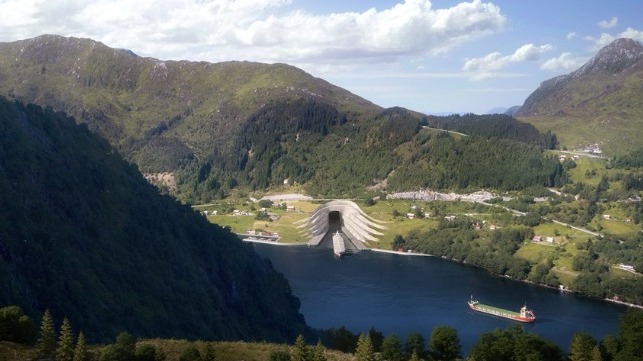Calling Suppliers: Norway Needs Tech for World's First Ship Tunnel

The Norwegian Coastal Administration (Kystverket) is building a one-of-a-kind maritime infrastructure project: the world's first full-size ship tunnel. It is a once-in-a-career opportunity for suppliers of maritime infrastructure systems, unlikely to be repeated on a decadal timescale, and the agency is calling for proposals.
The Stad Ship Tunnel will allow ships to circumvent a difficult area for navigation along the Norwegian coastline, the Stad Peninsula (Stadlandet). The area experiences stormy conditions about 30 percent of the time, and about 33 seafarers have lost their lives in nearby waters in the last 80 years. The weather is so bad that ancient Vikings used to haul their boats over a pass on the peninsula in order to avoid having to brave the journey around it.
The project was first proposed in the late 19th century, but the high cost of blasting through the peninsula's thick rock dissuaded the Norwegian government from pursuing construction. Still, Norwegian regulators have been studying the idea for decades, and a 160-foot by 120-foot wide by one-mile-long tunnel design received the green light in 2020. It will be big enough to allow the passage of Hurtigruten's Coastal Express passenger ferries, as well as smaller vessels like North Sea OSVs.
The Kystverket has allocated an initial investment of $325 million to the project and plans to bid it out on a fixed-price design/build contract basis. The basic design has substantial fendering on the sides to keep vessels safely in line, mooring piers at each end and escape walkways for crew/passenger evacuation if required. If all goes to plan, it will be completed and operational by 2026 - and it will be toll-free and open to all vessels (with pilotage and VTS management).

Illustration courtesy Snohetta / Kystverket
To make the tunnel as safe, functional and durable as possible, the Kystverket is reaching out to suppliers of technical solutions that could be adapted for use in a ship tunnel. No one has ever built one before, so this will be a rare opportunity for innovation.
"Although we are good at operating tunnels in Norway, this tunnel has completely different dimensions and will be built in a completely different environment to those we are used to. The technical equipment must be able to withstand sea water, corrosion, fog - conditions that are totally different to those in a normal road tunnel,” says Terje Skjeppestad, Project Manager for the Stad ship tunnel.
Skjeppestad's team wants to start a dialogue with suppliers early in the procurement process in order to solicit as many useful solutions as possible. Even though the prime EPC contractor will have the responsibility for the final product, Kystverket wants to understand the scope of what the market can offer and draw on the expertise of commercial players. The systems installed in the tunnel will have critical bearing on its functionality, so the agency wants to identify the "newest and best equipment." Kystverket is holding a supplier conference on January 31, 2023, but potential partners may wish to get into contact sooner.
“This could be equipment for fendering and entrance structures, cathodic protection systems or analyses of the light, sound and environment inside the tunnel,” says Skjeppestad. "We would . . . encourage suppliers who have experience of project planning and installation of technical equipment in road and railway tunnels, for example, to contact the project at [email protected]. As well as others who have innovative and robust solutions."
